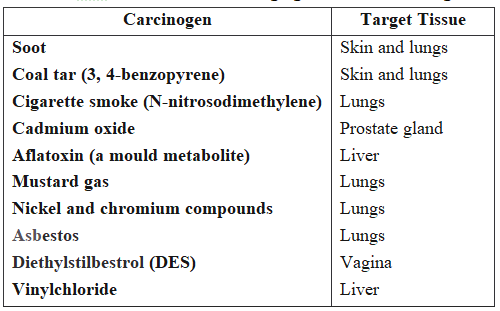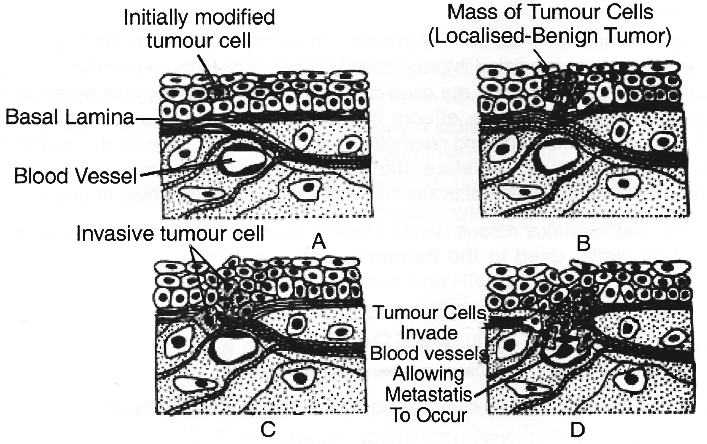- Books Name
- A TEXT OF BIOLOGY - CLASS XII
- Publication
- ACME SMART PUBLICATION
- Course
- CBSE Class 12
- Subject
- Biology
CANCER
Cancer is characterised by the uncontrolled multiplication of abnormal cells in the body.
The spread of cancerous cells to distant sites via blood is termed metastasis.
Normally cells show a property called contact inhibition by virtue of which contact with other cells inhibits their uncontrolled growth but cancer cells have lost this property.
It may be broadly classified into three major categories:
(a) Carcinomas are malignant growths of the epithelial (ectodermal) tissues that cover or line the body organs. e.g., skin cancer, breast cancer, lung cancer, cancer of the stomach and pancreas (about 85 percent of all tumors are carcinoma).
(b) Sarcomas are malignant growths arising in tissues derived from primitive mesoderm. e.g., bone tumors, muscle tumors, cancer of lymph nodes. They are rare in human beings (about 1 percent of all tumors).
(c) Leukaemias result from unchecked proliferation of cell types present in blood and their precursors in the bone marrow.
Cancer is a complex group of diseases that can affect many different body cells and tissues.
All cancers are characterized by the uncontrolled growth and division of cells.
Cancer leads to a mass of cells termed as neoplasm (Gr. for new formation) or tumor.
Abnormal and persistent cell division localized in a particular region is called benign tumor.
Benign tumor contains well-differentiated cells, not usually dangerous.
Tumor cells may be carried by blood stream or lymph or penetrate directly to other parts of the body resulting in dangerous malignant tumors and the spread of cancerous cells to distant sites is termed metastasis.
Other types of cancers are:
Melanoma : Cancer of pigment cells of the skin
Adenoma : Cancer of glands
Myoma : Cancer of muscular tissue
Lymphoma : Cancer of lymphatic tissue
Glioma : Cancer of glial cells of CNS
Oncology is the study of cancer.
All cells carry certain cancer associated proto-oncogenes.
Susceptibility to cancer depends upon familial factors, smoking, chemical and enviromental factors, viral factor, alcohol and dietary factors.
Any agent that induces a cancer is carcinogenic or oncogenic agent.
Exposure to ionizing radiations, such as X-rays, gamma rays, and non-ionizing UV-rays are said to induce cancer.
Chemical substances that can cause mutation are called carcinogens.
Physical irritants can also lead to cancer, such as continued abrasion of the lining of the intestinal tract by some type of food.
In many families, there is a strong hereditary tendency to cancer.
Viruses cause a number of specific cancers in animals.
Tumor producing viruses are called oncoviruses.
Table-III : Some Cancer causing agents and their Targets

Viruses are a second cause of cancer.
These agents are tiny packages of nucleic acids, either DNA or RNA, that are capable of infecting cells and converting them to virus-producers.
Although the link between viruses and cancer is strongly established for a variety of animal cancers, the relation in human cancers is less predictable.
Clearly, the number of people infected with these viruses is much larger than the number who develop cancer.
But evidence suggests that chronic viral infections are associated with up to one-fifth of all cancers. These include:
(a) Human T-cell leukemia virus-1 (HTLV-1), associated with leukemia, a malignant disease of bloodforming tissues, and lymphoma, a cancer of lymphatic tissue.
(b) Human immunodeficiency virus (HIV), associated with Kaposi's sarcoma, a cancer of blood vessels in the skin.
(c) Epstein-Barr virus (EBV), which causes infectious mononucleosis, associated with Burkitt's lymphoma, a cancer of white blood cells, nasopharyngeal carcinoma (common in Chinese males), and Hodgkin's disease -a lymphatic system cancer. Here Burkitt and Hodgkin are the names of discoverers.
(d) Hepatitis B virus (HBV), associated with liver cancer.
(e) Human papilloma virus (HPV), which causes genital warts (benign growths) associated with cancer of . the cervix, vagina, penis, and colon.
(f) Type 2 herpes simplex virus, which causes genital herpes, implicated in cancer of the cervix of the uterus.
Cancer may cause a variety of minor symptoms. Any that persist for several days should be checked by a doctor. The earlier a cancer is diagnosed the better the chance of cure
(a) Rapid weight loss without apparent cause
(b) A scab, sore of ulcer that fails to heal within 3 weeks
(c) A blemish or mole that enlarges, bleeds or itches
(d) Severe recurrent headaches
(e) Difficulty in swallowing (~ Persistent hoarseness of voice
(g) Coughing of blood sputum (phlegm)
(h) Persistent abdominal pain
(i) Change in shape or size of testes
(j) Blood in urine, with no pain on urination
(k) Change in bowel habits
(l) Lump or change in breast shape
(m) Bleeding or discharge from nipple
(n) Vaginal bleeding or spotting between periods or after menopause

Cells of malignant tumors duplicate continually and very often quickly and without control.
Such an increase in the number of cells due to an increase in the frequency of cell division is called hyperplasia.
Initially, malignant cells invade surrounding tissues.
As the cancer grows, it expands and begins to compete with normal tissues for space and nutrients.
Eventually, the normal tissue decreases in size (atrophies) and dies.
Following the nearby invasion, some of the malignant cells may detach from the initial (primary) tumor.
They may invade a body cavity or enter the blood or lymph, which can lead to widespread metastasis.
Next, those malignant cells that survive in the blood or lymph invade other body tissues and establish secondary tumors.
Finally, the secondary tumors become vascularized.
They undergo angiogenesis, which is the growth of new networks of blood vessels.
Any new tissue, whether it results from repairing a wound, normal growth, or tumors, requires a blood supply to deliver nutrients and oxygen.
Proteins that serve as chemical triggers for blood vessel growth in tumor tissue are called Tumor Angiogenesis Factors (TAFs).
In all stages of metastasis, the malignant cells resist the antitumor defenses of the body.
The pain associated with cancer develops when the growth puts pressure on nerves or blocks a passageway so that secretions build up pressure.
Cancer Detection and Diagnosis
Early detection of cancers is essential as it allows the disease to be treated successfully in many cases.
Cancer detection is based on biopsy and histopathological studies of the tissue and blood and bone marrow tests for increased cell counts in the case in leukemias.
In biopsy, a piece of suspected tissue cut into thin sections is stained and examined under microscope (histopathological studies) by a pathologist.
Techniques like radiography (use of X-rays), CT (Computed tomography) and MRI (Magnetic resonance imaging) are very useful to detect cancers of the internal organs.
MRI is the safest method for detection of cancer.
Computed Tomography uses X-rays to generate a three-dimensional image of the internal of an object.
MRI uses strong magnetic fields and non-ionising radiations to accurately detect pathological and physiological changes in the living tissue.
Antibodies against cancer-specific antigens are also used for detection of certain cancers.
For example, "Herceptin". Monoclonal antibodies are used for the diagnosis of breast cancer.
Techniques of molecular biology can be applied to detect genes in individuals with inherited susceptibility to certain cancers.
Identification of such genes, which predispose an individual to certain cancers, may be very helpful in prevention of cancers.
Such individuals may be advised to avoid exposure to particular carcinogens to which they are susceptible (e.g. tobacco smoke in case of lung cancer).
Treatment of Cancer
The common approaches for treatment of cancer are surgery, radiation therapy and immunotherapy.
In radiotherapy, tumor cells are irradiated lethally, taking proper care of the normal tissues surrounding the tumor mass.
Several chemotherapeutic drugs are used to kill cancerous cells.
Some of these are specific for particular tumors.
Majority of drugs have side effects like hair loss, anemia, etc.
Most cancers are treated by combination of surgery, radiotherapy and chemotherapy.
Tumor cells have been shown to avoid detection and destruction by immune system.
Therefore, the patients are given substances called biological response modifiers such as a-interferon which activate their immune system and help in destroying the tumor.
A common weed, Catharanthus roseus (Vinca rosea or Sadabahar), is the source of two anticancer drugs, Vincristin and Vinblastin, used in the treatment of leukaemia.

 ACME SMART PUBLICATION
ACME SMART PUBLICATION
